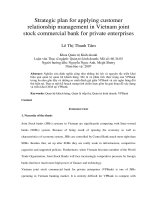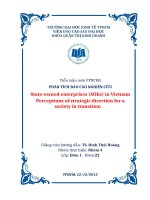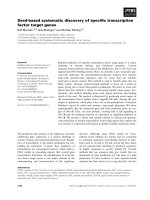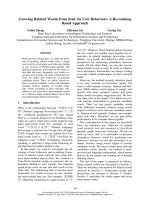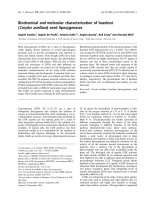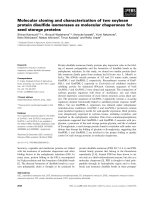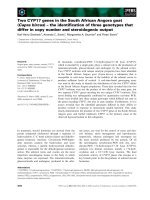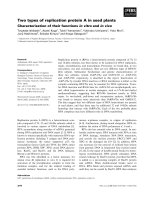african seed enterprises
Bạn đang xem bản rút gọn của tài liệu. Xem và tải ngay bản đầy đủ của tài liệu tại đây (3.93 MB, 254 trang )
African Seed Enterprises
Sowing the Seeds of Food Security
This page intentionally left blank
African Seed Enterprises
Sowing the Seeds of Food Security
Edited by
Paul Van Mele
Africa Rice Center (AfricaRice)
Jeffery W. Bentley
Bolivia
Robert G. Guéi
Food and Agriculture Organization of the United Nations
Italy
Published by
the Food and Agriculture Organization of the United Nations
and
the Africa Rice Center (AfricaRice)
by arrangement with
CAB International
CABI is a trading name of CAB International
CABI Head Offi ce CABI North American Offi ce
Nosworthy Way 875 Massachusetts Avenue
Wallingford 7th Floor
Oxfordshire OX10 8DE Cambridge, MA 02139
UK USA
Tel: +44 (0)1491 832111 Tel: +1 617 395 4056
Fax: +44 (0)1491 833508 Fax: +1 617 354 6875
E-mail: E-mail:
Website: www.cabi.org
© FAO and AfricaRice, 2011. All rights reserved. FAO and AfricaRice encourage reproduction and dissemination of
material in this information product. Non-commercial uses will be authorized free of charge upon request. Reproduction
for resale or other commercial purposes, including educational purposes, may incur fees. Applications for permission
to reproduce or disseminate FAO copyright materials and all other queries on rights and licences should be addressed
by email to or to the Chief, Publishing Policy and Support Branch, Offi ce of Knowledge Exchange,
Research and Extension, FAO, Viale delle Termi di Caracalla, 00153 Rome, Italy. Applications for permission to
reproduce or disseminate AfricaRice copyright materials should be made to or to the Head,
Marketing and Communications, AfricaRice, 01 B.P. 2031 Cotonou, Benin.
A catalogue record for this book is available from the British Library, London, UK.
Library of Congress Cataloging-in-Publication Data
African seed enterprises : sowing the seeds of food security / edited by Paul Van Mele, Jeffery W. Bentley, Robert G. Guéi.
p. cm.
Includes bibliographical references and index.
ISBN 978-1-84593-843-7 (alk. paper) ISBN 978-1-84593-863-5 (pbk. : alk. paper) ISBN 978-9-25106-687-4 (fao pbk. :
alk. paper) 1. Seed industry and trade Africa Case studies. 2. Seeds Economic aspects Africa. 3. Seeds Africa Marketing. 4.
Food crops Seeds Africa. I. Mele, Paul van. II. Bentley, Jeffery W. (Jeffery Westwood), 1955- III. Guéi, Robert G. IV. Title.
HD9019.S432A353 2011
338.1'7 dc22
2011003331
All photos are copyrighted by the individual contributors. Alfa Oumar Baldé (p. 103); Abdoulaye Barra (p. 32, 35); Hassan
Benaouda (p. 140); Jeffery W. Bentley (p. 3, 41, 44, 45, 49, 51, 52, 55, 56, 58, 61, 124, 216); Abdellaziz Chetto (p. 134,
137); D. Dalohoun (p. 105); Dioukamady Diallo (p. 79); Michael Misiko (p. 146, 147, 150, 152); Florent Okry (p. 93);
Ketamalala Randriamilandy (p. 183, 187, 197, 199); J. David Reece (p. 121); J.C. Rubyogo (p. 177); Louise Sperling (p. 73);
Paul Van Mele (p. 6, 66, 71, 77, 85, 86, 90, 94, 97, 110, 112, 119, 157, 160, 165, 167, 168, 182, 186, 219, 222); Tom van
Mourik (p. 82); M. Vrolijks (p. 194, 195, 204); and Eva Weltzien (p. 220).
Cover design: Marcella Vrolijks
Map production and design: Chabi Adeyemi and Marcella Vrolijks
ISBN-13: 978 1 84593 843 7 (CABI hardback)
ISBN-13: 978 1 84593 863 5 (Africa Rice paperback)
ISBN-13: 978 9 25106 687 4 (FAO paperback)
The designations employed and the presentation of material in this publication do not imply the expression of any
opinion whatsoever on the part of the Food and Agriculture Organization of the United Nations and the Africa
Rice Center concerning the legal status of any country, territory, city or area or of its authorities, or concerning the
delimitation of its frontiers or boundaries. The mention of specifi c companies or products of manufacturers, whether or
not these have been patented, does not imply that these have been endorsed or recommended by FAO or AfricaRice in
preference to others of a similar nature that are not mentioned. The views expressed herein are those of the authors and
do not necessarily represent those of FAO or AfricaRice.
Correct citation: Van Mele, P., Bentley, J.W. and Guéi, R.G. (eds) 2011. African Seed Enterprises: Sowing the Seeds of
Food Security. CAB International, Wallingford, UK, 256 pp.
Commissioning editor: Nigel Farrar
Production editor: Fiona Chippendale
Typeset by SPi, Pondicherry, India.
Printed and bound by Gutenberg Press, Malta.
v
Contents
Contributors viii
Foreword xi
Introduction to this Book xiii
Acknowledgements xv
List of Tables xvi
List of Boxes xviii
1 Introduction: a Full Granary 1
Robert G. Guéi, Jeffery W. Bentley and Paul Van Mele
1.1 Why We Study Success Stories 1
1.2 The Issues 2
1.3 Case Studies in Brazil, India and Côte d’Ivoire 4
1.4 Method 5
1.5 How the Book is Organized 5
1.6 Audience 7
2 How Seed Works 8
Jeffery W. Bentley, Paul Van Mele and J. David Reece
2.1 Formal and Informal Systems 8
2.2 Demand for Seed 9
2.3 Supply of Seed 12
2.4 Enterprises in Africa 16
2.5 Organizing Farmers to Produce Seed 20
2.6 Conclusion 21
3 Cameroon: Revolving Funds Make a Difference 25
Drissa Silué, Abdoulaye Barra and Robert G. Guéi
3.1 Introduction 25
3.2 The Aoudi Sanguéré Federation 30
3.3 The Sayem Seed Producers Union 32
3.4 The Agrelenas Seed Producers Group 34
3.5 Challenges and Strengths of the Seed Enterprises 35
vi Contents
4 Nigeria: Clustered Seed Companies 38
Jeffery W. Bentley, Olupomi Ajayi and Kehinde Adelugba
4.1 Introduction 38
4.2 The Share Foundation 43
4.3 The Agricultural Development Projects (ADPs) 45
4.4 Premier Seed Nigeria 50
4.5 Nagari Seed Nigeria 53
4.6 Terratiga 55
4.7 The Seed Project Company 57
4.8 Maslaha Seeds Nigeria 60
4.9 Challenges and Strengths of the Seed Enterprises 62
5 Mali: When Government Gives Entrepreneurs Room to Grow 65
Daniel N. Dalohoun, Paul Van Mele, Eva Weltzien, Dioukamady Diallo,
Hamidou Guindo and Kirsten vom Brocke
5.1 Introduction 65
5.2 Faso Kaba 70
5.3 Niégué Farm 75
5.4 Nipagnon Cooperative 78
5.5 COPROSEM 80
5.6 Pearl Millet Seed-producing Villages in Dogon Country 82
5.7 Challenges and Strengths of the Seed Enterprises 86
6 Guinea: Networks that Work 89
Florent Okry, Daniel N. Dalohoun, Sékou Diawara, M. Billo Barry
and Paul Van Mele
6.1 Introduction 89
6.2 Mama Adama Yansané 92
6.3 Ibrahima Sherif 95
6.4 Comptoir Agricole 98
6.5 Cereal and Potato Seed Producers’ Union 101
6.6 El-Hadj Tafsir Sow 104
6.7 Challenges and Strengths of the Seed Enterprises 106
7 The Gambia: Capturing the Media 109
J. David Reece, Daniel N. Dalohoun, Essa Drammeh, Paul Van Mele
and Saidu Bah
7.1 Introduction 109
7.2 Gambia Horticultural Enterprises 115
7.3 Jambur Kafo 118
7.4 Jafaye Farm 125
7.5 Challenges and Strengths of the Seed Enterprises 129
7.6 Conclusions 130
8 Morocco: the Visible Hand 133
Abderrahmane Lyamani, Drissa Silué and Robert G. Guéi
8.1 Introduction 133
Contents
vii
8.2 The SONACOS Seed Enterprise 139
8.3 Challenges and Strengths 141
9 Kenya: a Company, a Cooperative and a Family 142
Michael Misiko, Conny Almekinders, Ian Barker, Dina Borus,
Judith Oggema and John Mukalama
9.1 Introduction 142
9.2 Western Seed Company 145
9.3 Mumias District Federation of Soybean Producers 149
9.4 Sungus Seed Potato Enterprise 151
9.5 Challenges and Strengths of the Seed Enterprises 154
10 Uganda: Dreams of Starting a Company 156
Paul Van Mele, Michael A. Ugen, David Wanyama, Robert Anyang,
Jean Claude Rubyogo and Louise Sperling
10.1 Introduction 156
10.2 Nalweyo Seed Company (NASECO) 161
10.3 Bakusekamajja Women Farmers’ Development Association 168
10.4 Nyamabale Bean Seed Producers’ Association 173
10.5 Challenges and Strengths of the Seed Enterprises 177
11 Madagascar: Coping with Relief Aid and Politics 181
Paul Van Mele, Ketamalala Randriamilandy, Noroseheno Ralisoa
and Raymond Rabeson
11.1 Introduction 181
11.2 Valy Prod Sem 187
11.3 Seed Multiplication Centre (CMS) – Sakay 190
11.4 SCAA 194
11.5 Andri-Ko 196
11.6 FIFAMANOR 201
11.7 Meva Seed Potato Growers’ Cooperative 205
11.8 Challenges and Strengths of the Seed Enterprises 208
12 Conclusions 210
Jeffery W. Bentley, Paul Van Mele and Robert G. Guéi
12.1 There is Life After Structural Adjustment 210
12.2 Overview of the Book 210
12.3 Unique Challenges of Four Crop Types 212
12.4 Business Models 213
12.5 What Makes Seed Enterprises Tick 218
12.6 How to Encourage Seed Enterprises 220
12.7 Conclusions 222
Acronyms and Abbreviations 225
Glossary of Terms 229
Index 231
viii
Contributors
The Editors
Paul Van Mele is an agricultural scientist from Ghent University, Belgium, who
obtained his PhD studying Vietnamese fruit farmers’ knowledge of pests, natural
enemies and pesticides (Wageningen University, 2000). He wrote Ants as Friends
(2003) and edited Way out of the Woods (2003) and Innovations in Rural Extension
(2005). In 2004, his video project with rural women in Bangladesh won an interna-
tional award for effective communication. From 2005 to 2010, Paul Van Mele lived
in Benin, working as programme leader, Learning and Innovation Systems at
AfricaRice. His work with farmers, video and rural radio earned him the 2009
CGIAR Science Award for outstanding communications. He currently runs his own
enterprise Agro-Insight, based in Belgium.
Jeffery W. Bentley is an agricultural anthropologist (PhD, University of Arizona,
1986). He lived in Portugal for a year, doing participant observation with smallholder
farmers (1983–84). He spent 7 years in Honduras (1987–94) at Zamorano, an agri-
cultural college, helping researchers and smallholders create appropriate integrated
pest management technology. He is the author of various articles, books and manu-
als, including Today There Is No Misery (1992) and Manual for Collaborative
Research with Smallholder Farmers (with Peter Baker, 2002). Jeff Bentley has lived in
Bolivia since 1994 and is an international consultant.
Robert G. Guéi is a plant breeder and a geneticist (PhD, Kansas State University,
1991). He spent 14 years at AfricaRice (formerly called WARDA), initially as rice
breeder, then as coordinator of the international network of genetic evaluation of rice
and finally as Head of the Genetic Resources Unit. Since 2005, he has worked at FAO
as an agricultural officer and seed expert. He lives in Rome and has a global responsi-
bility to help countries develop their seed systems. He is the author of various scientific
papers, book chapters and manuals, and technical and policy guides, including several
on community seed enterprise development. He recently edited the NERICA Rice
Compendium.
Authors
Adelugba, Kehinde, National Agricultural Seed Council (NASC), Abuja, Nigeria;
E-mail:
Ajayi, Olupomi, Africa Rice Center (AfricaRice), Ibadan, Nigeria; E-mail: o.j.ajayi-ng@
cgiar.org
Almekinders, Conny, Wageningen University and Research Centre (WUR),
Wageningen, The Netherlands; E-mail:
Contributors
ix
Anyang, Robert, Africa Rice Center (AfricaRice), Dar es Salaam, Tanzania; E-mail:
Bah, Saidu, Africa Rice Center (AfricaRice), Cotonou, Benin; E-mail:
Barker, Ian, International Potato Center (CIP), Nairobi, Kenya; E-mail: i.barker@
cgiar.org
Barra, Abdoulaye, Ministry of Agriculture and Rural Development, Garoua,
Cameroon; E-mail:
Barry, M. Billo, Institut de recherche agronomique de Guinée (IRAG), Conakry,
Guinea; E-mail:
Bentley, Jeffery W., Independent consultant, Cochabamba, Bolivia; E-mail: jeffery-
Borus, Dinah, International Potato Center (CIP), Nairobi, Kenya; E-mail: d.borus@
cgiar.org
Dalohoun, Daniel N., Africa Rice Center (AfricaRice), Cotonou, Benin; E-mail:
Diallo, Dioukamady, Laboratoire des Semences (LABOSEM), Sotuba, Mali; E-mail:
Diawara, Sékou, Institut de recherche agronomique de Guinée (IRAG), Conakry,
Guinea; E-mail:
Drammeh, Essa, National Agricultural Research Institute (NARI), Sapu, The
Gambia; E-mail:
Guéi, Robert G., Food and Agriculture Organization (FAO), Rome, Italy; E-mail:
Guindo, Hamidou, Direction Régional Agriculture, Gao, Mali; E-mail: hamidguindo@
yahoo.fr
Lyamani, Abderrahmane, Kénitra, Morocco, E-mail:
Misiko, Michael, Africa Rice Center (AfricaRice), Cotonou, Benin; E-mail: m.misiko@
cgiar.org
Mukalama, John, International Center for Tropical Agriculture (CIAT), Maseno,
Kenya; E-mail:
Oggema, Judith, Agricultural Development Corporation (ADC), Molo, Kenya;
E-mail:
Okry, Florent, Africa Rice Center (AfricaRice), Cotonou, Benin; E-mail: okryflorent@
yahoo.fr
Rabeson, Raymond, FOFIFA, Antananarivo, Madagascar; E-mail: rabeson_ raymond@
moov.mg
Ralisoa, Noroseheno, FIFAMANOR, Andranomanelatra Antsirabe, Madagascar;
E-mail:
Randriamilandy, Ketamalala, Service Officiel de Contrôle des Semences (SOC),
Antananarivo, Madagascar; E-mail:
Reece, J. David, Africa Rice Center (AfricaRice), Cotonou, Benin; E-mail: j.d.reece@
cgiar.org
Rubyogo, Jean Claude, International Center for Tropical Agriculture (CIAT),
Lilongwe, Malawi; E-mail:
Silué, Drissa, c/o World Vegetable Center (AVRDC), Arusha, Tanzania; E-mail: silue.
Sperling, Louise, International Center for Tropical Agriculture (CIAT), Arusha,
Tanzania; E-mail:
x Contributors
Ugen, Michael A., National Agricultural Research Organization (NARO), Namulonge,
Uganda; E-mail:
Van Mele, Paul, Africa Rice Center (AfricaRice), currently Agro-Insight, Ghent,
Belgium; E-mail:
vom Brocke, Kirsten, International Crops Research Institute for the Semi-Arid
Tropics (ICRISAT), Bamako, Mali; E-mail:
Wanyama, David, National Seed Certification Service (NCRS), Entebbe, Uganda;
E-mail:
Weltzien, Eva, International Crops Research Institute for the Semi-Arid Tropics
(ICRISAT), Bamako, Mali; E-mail:
xi
Foreword
The world is currently struggling to harness its resources to meet the growing
challenges of food production in the face of population growth, climate change and
increased prices of energy and other production factors. The second World Seed
Conference (Rome, 8–9 September 2009) revealed that the global seed market has
grown rapidly in recent years and is currently around US$37 billion. However, devel-
oping countries are yet to be part of the major seed trade. The conference therefore
called for urgent government measures to increase public and private investments in
the seed sector for agriculture to meet the challenge of food security.
It is gratifying to note that, in all African countries, some arrangements exist to
provide seeds for farmers, attesting to the recognition by African governments that
this input is critical for food security. However, in spite of good intentions, seed
programmes often do not or no longer meet the needs of farmers. In southern and
eastern Africa, private sector participation is more advanced, resulting in relatively
better developed seed industries, even if only for a few selected and commercially
attractive crops. In the rest of Africa, the rapid pace of seed sector development in the
past seems not to have resulted in sustainable programmes, as most of it is
concentrated on state farms, parastatals and other publicly funded and operated seed
activities across the board. Economically they were not sustainable as public budgets
dwindled and donor support waned.
The recent trend is for the public sector to disengage from seed production,
although responsibility for early generation seed production continues to be entrusted
to some public funded agencies.
As the public sector withdraws, the degree of abandonment of seeds of crops (self-
and cross-pollinated) important to food security but of little interest to multinational
companies becomes even more pronounced and that of vegetatively propagated crops
such as cassava, plantains and yams even direr. Indeed, this is the present situation in
most countries where seed development is following modern trends. Clearly some
imaginative ways have to be found to enable a sustainable seed production and distri-
bution effort to take off for food security crops in Africa.
As an initial step, FAO and AfricaRice joined efforts to document, throughout
Africa, success stories of small and medium-sized seed enterprises dealing with non-
hybrid food crops and identify the factors behind their success.
The case studies from nine African countries presented in this book provide an
overview of the current status of the African seed sector, and associated challenges
and opportunities. They form a solid basis for a broad-based discussion on how to
strengthen the sector to the benefit of food security across the continent.
The studies showed that the challenges facing the seed sector in Africa are many
and varied including at institutional and infrastructure levels. However, many African
xii Foreword
seed enterprises are able to bring together the formal and informal seed sectors in
rather innovative ways, thereby assuring a flow of improved seeds to small farmers.
The sustainable development of these enterprises is challenging in most countries due
to the absence of an enabling environment. Entrepreneurs face non-adapted legisla-
tion, poor infrastructure, lack of appropriate financial products and business support
services and lack of training. The extent to which each country is able to address these
challenges and empower all the major actors will undoubtedly positively impact the
growth of the seed sector.
The lessons learnt from these studies should help support the rapid development
of the African seed sector and increase the steady supply of quality seed of food secu-
rity crops to millions of African smallholder farmers.
Modibo T. Traoré Papa A. Seck
Assistant Director-General Director General
Agriculture and Consumer Protection Department AfricaRice
Food and Agriculture Organization of the United Nations
xiii
Introduction to this Book
The subject of seed provision commands an exceptional amount of attention in most
discussions of agricultural development. The reasons are not difficult to understand,
as the security and quality of seed supply are among the principal determinants of any
farmer’s success. But, despite this unanimity of interest, there is relatively little agree-
ment on what needs to be done to support the growth of effective and equitable seed
provision in developing countries.
Part of the controversy over seed provision is the product of legitimate concerns
about the nature and impact of the commercial seed sector. There is, for instance, the
danger that an overemphasis on commercial seed supply will disregard the role that
farmers continue to play in the identification and preservation of productive germ-
plasm, the maintenance of local systems of seed sale and exchange, and innovations in
crop management. In addition, there are understandable worries about the growing
reach of the multinational ‘life sciences’ industry, its increasing control of the seed sec-
tor and the concentration of access to technology in too few hands.
But commercial seed supply can take many different forms, and it is a larger part
of many ‘traditional’ farming systems than people may realize. It is difficult to imagine
a productive agricultural system in the 21st century without access to some type of
formal seed provision through various types of seed enterprise. As agricultural econo-
mies develop there is a natural shift towards specialization in the supply of products
and services that were previously part of self-sufficient farms or communities. The
access to commercial seed supply offers wider access to the products of modern plant
breeding and helps ensure that a farmer’s seed supply is not completely dependent on
the vagaries of local climate or other uncertainties in local production systems. In addi-
tion, the expansion of agricultural markets often provides farmers with an opportunity
to earn a premium for the specific qualities of their produce, which may require more
attention to high quality and uniform seed than can be provided on-farm. The avail-
ability of commercial seed also allows the farmer to invest time in other activities,
on- or off-farm, without having to worry about next year’s seed supply.
Seed is a special product, embodying specific genetic information as well as
important physical qualities, and as such its commerce offers particular challenges
and opportunities. Some of the challenges are related to the fact that many of the
seed’s qualities are not immediately obvious to the buyer and hence some type of
regulatory system may be required. But, even where seed regulatory regimes are in
place, they are rarely successful unless there is a concomitant exercise of farmers’ own
capacities to understand input markets and to learn about the products on offer, and
the investment of seed suppliers in establishing and promoting their reputations in the
farming community. Formal seed provision thus offers a stimulus to the expansion of
robust agricultural markets by developing the trust and knowledge that allows
participants to make productive exchanges.
xiv Introduction to this Book
The expansion of formal seed provision also offers other contributions to the
development of the agricultural economy. The inability of public plant breeding pro-
grammes to deliver many of their varieties to farmers has been a chronic problem.
The emergence of local seed enterprises (many of which will depend, at least initially,
on public varieties) offers a solution to this dilemma, places increased pressure on
public research to deliver products that farmers can use and offers opportunities for
productive public–private interactions that are crucial to agricultural development.
Although there are some economies of scale in seed production, experience has
shown that relatively small seed companies can be viable, thus offering the opportu-
nity to contribute to the development of small and medium-size businesses supporting
local agriculture. In addition, the fact that most commercial seed production is done
through contracted seed growers offers an opportunity for some farmers to increase
their earnings through specialized production.
There has been much investment by donors and national governments over the
past several decades in support of the formal seed sector in developing countries.
Some of those investments are beginning to pay off, but there is much that remains
to be done. This is particularly true in sub-Saharan Africa, where there are many
challenges to establishing viable businesses. Although the literature on seed systems
includes various attempts to describe patterns of seed enterprise growth and to deline-
ate distinct stages in seed industry development, these tend to be oversimplified
approximations. The reality is much more complex and idiosyncratic. The perform-
ance and prospects of seed enterprises depend on a wide range of factors, including
the specific crops, the characteristics of national agricultural economies and the
adequacy of local institutions.
There is thus much to be learned about what is needed to ensure seed enterprise
development. That is why African Seed Enterprises is important, because this book
describes an exceptionally wide range of experiences in sub-Saharan African countries.
Each of the cases is substantially unique and presents a particular history and set of
lessons. The descriptions are accompanied by country profiles that allow the reader
to appreciate the agricultural and policy environment that determines the trajectory
of these enterprises. Not all of the enterprises described in this book are likely to
survive, and some are still perilously small operations or highly dependent on exter-
nal support. But their experience to date offers an exceptionally rich source of data
and ideas for understanding seed systems and appreciating the diversity of strategies
and resources that have been used to create new seed enterprises. These are the varied
and often imperfectly formed building blocks from which viable commercial seed
systems are being constructed. The experiences should be of great use to governments
and donors when they consider how to provide more adequate support to seed enter-
prise development.
Robert Tripp
xv
Acknowledgements
We thank Marco Wopereis for encouraging this study and for reading an earlier ver-
sion of this book; AfricaRice for allowing staff to work on this study and for provid-
ing office space and logistical support; FAO for initiating and supporting this study.
Additional resources were provided by USAID and IFAD. The Netherlands
Organization for International Cooperation in Higher Education (NUFFIC) partly
funded the research in Guinea, as part of a PhD programme.
We thank all the national programmes and seed entrepreneurs featured in this
book who shared their valuable time and insights.
We thank Abdoulaye Kabore, Louis Béavogui, Malick Soumah, Moustapha
Ceesay and N’Famoussa Camara for their assistance in collecting additional data.
Aliou Diagne provided input for Chapter 2. Abderrahmane Lyamani, Cathelijne
van Melle, Daniel Dalohoun, David Wanyama, Dinah Borus, Djoukamady Diallo,
Drissa Silué, Essa Drammeh, Florent Okry, Jean Claude Rubyogo, Judith Oggema,
David Reece, Kehinde Adelugba, Marco Wopereis, Michael Misiko, Olupomi Ajayi,
Sékou Diawara and Tom Remington contributed ideas to the concluding chapter.
Conny Almekinders and Graham Thiele kindly provided constructive criticism on
an earlier version of this book.
Other people who reviewed one or more chapters are Clive Drew, Louise
Sperling, Marco Wopereis, Peter Matlon, Solveig Danielsen and Tom Remington.
xvi
List of Tables
Table 2.1 Formal vs informal seed systems 9
Table 2.2 Important biological features of some major crop types 10
Table 3.1 Seed certified (tonnes) in Cameroon, 2006–2009 27
Table 3.2 Certified seed produced (tonnes) under FAO project 27
Table 3.3 Evolution of rice seed producer groups 28
Table 3.4 Evolution of maize, sorghum and millet seed producer groups 29
Table 3.5 Foundation seed produced (tonnes), Aoudi Sanguéré Federation 31
Table 3.6 Clients of the Aoudi Sanguéré Federation 32
Table 3.7 Quality rice seed produced, Sayem Union 32
Table 3.8 Quality seed produced, Agrelenas group 34
Table 4.1 Seed certified (tonnes) in Nigeria, 2005–2009 39
Table 4.2 Certified seed produced (tonnes), Kaduna ADP outgrowers, 2008 47
Table 4.3 Seed produced (tonnes), Premier Seed 51
Table 4.4 Clients of Nagari Seed 55
Table 4.5 Certified seed produced (tonnes), Seed Project 57
Table 4.6 Clients of Seed Project 59
Table 4.7 Seed produced (tonnes), Maslaha Seeds 60
Table 4.8 Clients of Maslaha Seeds 62
Table 5.1 Seed certified (tonnes) in Mali, 2005–2009 68
Table 5.2 Seed sold (tonnes), Faso Kaba 71
Table 5.3 Clients of Faso Kaba 74
Table 5.4 Rice seed produced (tonnes), Niégué Farm 76
Table 5.5 Seed produced (tonnes), Nipagnon 78
Table 5.6 Seed produced by COPROSEM 80
Table 5.7 Clients of COPROSEM 81
Table 6.1 Clients of Mama Adama Yansané 95
Table 6.2 Rice seed produced (tonnes), Ibrahima Sherif 96
Table 6.3 Clients of Ibrahima Sherif 98
Table 6.4 Seed sales (tonnes), Comptoir Agricole 99
Table 6.5 Rice seed supplied (tonnes) to Comptoir Agricole 99
Table 6.6 Clients of Comptoir Agricole 101
Table 6.7 Seed produced, Cereal and Potato Seed Producers’ Union 101
Table 6.8 Seed produced, El-Hadj Sow 105
Table 6.9 Clients of El-Hadj Sow 106
Table 7.1 Nerica foundation seed production (tonnes),
The Gambia, 2006–2009 112
Table 7.2 Seed sales, Gambia Horticultural Enterprises 116
Table 7.3 Clients of Gambia Horticultural Enterprises 117
List of Tables
xvii
Table 7.4 Rice seed produced (tonnes), Jambur Kafo 120
Table 7.5 Clients of Jambur Kafo 123
Table 7.6 Rice seed production, Jafaye Farm 125
Table 8.1 Financial incentives to promote seed systems in Morocco 135
Table 8.2 Certified seed use in Morocco 135
Table 8.3 Achievements of INRA annual crops breeding programme 136
Table 8.4 Distribution of private seed companies in Morocco 138
Table 9.1 Seed of crops certified (tonnes) in Kenya, 2004–2009 144
Table 10.1 Seed certified (tonnes) in Uganda, 2004–2009 159
Table 10.2 Seed produced (tonnes), NASECO 163
Table 10.3 Clients of NASECO 166
Table 10.4 Seed produced (tonnes), Bakusekamajja Women Farmers’
Development Association 169
Table 10.5 Clients of the Bakusekamajja Women Farmers’
Development Association 172
Table 10.6 Bean varieties selected by Nyamabale farmers 174
Table 10.7 Seed supplied (tonnes) by the Nyamabale Association 174
Table 10.8 Clients of the Nyamabale Association 177
Table 11.1 Seed certified (tonnes) in Madagascar, 2004–2009 185
Table 11.2 Seed produced (tonnes), Valy Prod Sem 188
Table 11.3 Clients of Valy Prod Sem 190
Table 11.4 Seed produced (tonnes), CMS – Sakay 191
Table 11.5 Clients of CMS – Sakay 193
Table 11.6 Certified seed produced (tonnes), Andri-Ko 198
Table 11.7 Clients of Andri-Ko 200
Table 11.8 Seed produced (tonnes), FIFAMANOR 201
Table 11.9 Clients of FIFAMANOR 204
Table 11.10 Seed produced (tonnes), Meva cooperative 205
Table 11.11 Clients of Meva cooperative 207
xviii
List of Boxes
Box 1.1 Definition 1
Box 4.1 A Nerica seed grower in Kaduna 47
Box 4.2 Seed growers of Bida Bidi 48
Box 5.1 Termites speed up rural financing 68
Box 5.2 Demands for seed diversity 69
Box 5.3 A bad experience turning sour 75
Box 5.4 Pearl millet seed from Tabi 84
Box 6.1 The unspoken profession 92
Box 7.1 Bangladeshi seed videos on TV 114
Box 7.2 God will reward him 128
Box 9.1 The ideal variety: does it exist? 148
Box 10.1 The challenge of cowpea seed 162
Box 10.2 The story of an outgrower 164
Box 10.3 El-Shaddai International, Uganda’s largest seed distributor 167
Box 10.4 Growing Nerica seed at the expense of food security? 169
Box 10.5 Scaring birds in a silent way 170
Box 10.6 Making money with bean seeds 175
Box 11.1 A mason turns to seed 189
Box 11.2 Sweet potato vine growers 202
Box 11.3 Barley for the brewery 207
©FAO and AfricaRice 2011. African Seed Enterprises (Van Mele et al.) 1
1 Introduction: a Full Granary
ROBERT G. GUÉI, JEFFERY W. BENTLEY
AND PAUL VAN MELE
1.1 Why We Study Success Stories
A granary full of cereal can start with a single seed, the most renewable agricultural
resource. But seed is also alive and delicate, and in most developing countries farmers
still cannot get enough good quality seed to make their countries food secure. Farmers
often can only get quality seed if there are viable seed enterprises that multiply, store
and distribute seeds. These enterprises can be small family farms, public agencies and
medium-sized companies. This book takes a people-centred look at those enterprises,
at the people with the skills, talent and gumption to open the doors of a business as
difficult as seed, and to keep it running in a place as challenging as Africa.
Seed is often expensive, placing poor farmers at a disadvantage. Large seed com-
panies concentrate more on countries with big farmers and a large demand for seed,
especially hybrid maize and vegetable seed. They often ignore seeds with thin profit
margins, such as self-pollinated crops, like wheat, rice and beans, open-pollinated
crops like non-hybrid maize or vegetatively propagated crops, because farmers often
save the seeds from one harvest to the next and because proprietary laws are missing
or not enforced. However, these are the crops still widely grown by most smallholder
farmers, providing food and employment for themselves and others. Letting farmers
try new varieties and then distributing the seed will be crucial as the world adapts to
climate change.
Nevertheless, there are a few unsung
examples in Africa and elsewhere of
successful seed enterprises (see Box 1.1)
running on less equipment and modest
capital investment. It is important to
identify and describe their unique expe-
riences in the search to build durable,
quality seed systems in Africa.
Recent case studies by FAO and
partners in Brazil, India, Côte d’Ivoire
and nine other African countries aim
to find the constraints and the keys to
overcoming them to build successful
seed enterprises. We hope that the business models and experiences will inspire
others to produce and distribute seed for Africa’s food security crops. The seed
for these crops is less profitable than vegetable seed or hybrid maize, but it is
possible to make money and serve the community at the same time, as the cases
in this book show.
Box 1.1 Definition.
Successful seed enterprise. Any farmer,
association, small or medium-sized com-
pany, public agency or any other person or
group that is able to stay in business for
several years, producing or selling seed,
overcoming the cash flow challenges of
seed. The enterprise keeps its customers
or finds new ones by offering quality seed
and by creating new products and services.
The enterprise should be able to manage
and finance itself.
2 R.G. Guéi et al.
1.2 The Issues
Specializing in seed is difficult. Farmers must have the seed ready at planting time,
which means they must either grow it off-season, save it from the previous harvest or
bring it from somewhere else. They must invest time and money months before their
product is ready to sell, only to find that by planting time many of the seed customers
are out of money.
The seed must be of high quality. Farmers disappointed by poor germination or
by seed-borne disease lose confidence in the seed producers. Seed has to be planted
and tended to know if it is any good (Tripp, 2001). So certification, or brand names,
became a way of signalling quality, but the certifier and the enterprise must keep a
consistent high quality.
To grow healthy seed, a crop must be in excellent condition. The field needs to
be kept especially free of weeds and diseases to avoid passing health problems on to
the next generation. Formal seed is often dusted with a coating of fungicide as an
added protection. Then the seed must be packaged, labelled and marketed.
In spite of these problems with cash flow and quality, in the 1980s some develop-
ment workers began to see an inherent logic in encouraging smallholder farmers to
produce the seed for common food crops, especially self-pollinated (like rice, finger
millet, beans, cowpea and groundnuts) and cross-pollinated crops like maize, sor-
ghum and pearl millet. After all, the farmers were already producing and managing
seed for their own crops, often selling or giving seed to their neighbours as well. With
a little effort they could grow seed to sell as well. Plus the farmers as seed producers
were close (geographically and culturally) to their potential clients. And there was the
appeal of giving relatively low-income people a new money earner, while promoting
new, high yielding or disease resistant crop varieties.
But it wasn’t as simple as that. Producing seed for sale at a larger scale requires
many steps which are omitted in farm-saved seed. National seed regulations often
inhibit trade by unregistered entrepreneurs or trade of local varieties that are not
included in the national seed catalogue (De Schutter, 2009). Those interested in
becoming a seed producer must have ties with research and plant breeders to get the
‘foundation seed’ needed to grow certified seed. Then the producers must contact a
perhaps distant government seed certification agency and arrange for inspections
while the seed crop is in the field. This costs money and requires management skills
and contacts. Turning village farmers into a group of organized seed producers
requires that they work together, from seed to sale, while often the farmers find it
easier to do most tasks alone or just with household members.
Government seed certification agencies tend to have limited staff and slim travel
budgets and cannot inspect seed plots of hundreds of scattered smallholder seed pro-
ducers. But, if outgrowers work as a group and sow their crop at the same time, all
plots in a given area can be inspected on the same day. However, organizing farmers
is easier said than done. They find it easier to take decisions and organize their work
at the household level (Netting, 1993).
Producing and distributing high quality seed often require investment in labour,
machinery, chemicals, processing and storage facilities, packaging and marketing.
Investors only embark on it if they are sure of having a return to their investment. After
independence, African countries understood that in order to feed their populations agri-
cultural development should go hand in hand with the development of their seed sector.
Introduction
3
In the absence of a private sector, gov-
ernments invested heavily in producing
seed of most of their food security crops,
most of which are either self-pollinated,
open-pollinated or vegetatively propa-
gated. Although some were successful,
the structural adjustment policy in the
1980s forced governments to abandon
seed production and distribution with-
out considering the difficulties for the
private sector to assume responsibility
for producing the less profitable seeds of
food security crops.
Many countries have encouraged
privatization and withdrawn from
investment in plant breeding and seed
production. Over 90% of the crops in
developing countries are grown from
farm-saved seed (Minot et al., 2007), although much of the saved seed is of modern,
high-yielding varieties. However, on the whole, private businesses did not come for-
ward to fill the gap left by government withdrawal. Donors and NGOs started to
support farmer seed production.
After food prices spiked in 2008, African governments became concerned about
increasing their food production, in part to lower the costs of importing food, espe-
cially rice. Yet African farmers who were planting modern crop varieties were reaping
harvests of up to double those of their neighbours. And governments complained
that, years after national and international centres had released new varieties, the
seeds were still in short supply. By 2010, African governments, the FAO and other
donors were once again emphasizing improved seed.
Global changes. In 2050 the world’s population will be 9.1 billion, 34% higher
than in 2010. All population increase will occur in developing countries, particularly
in Africa. Seventy per cent of the world’s population will then be urban, compared
with just 49% today (FAO, 2009). Food production must increase by 70% to feed
this larger, more urbanized and wealthier population (which will buy more meat,
milk and eggs). The world will need genetic diversity to adapt to global warming. As
farmers respond to improved transportation and opportunities to sell new crops,
from fruits and vegetables to biofuels, they will need a more constant access to seeds
of new crops and varieties. Changes in world market prices also affect choices made
by the local agroprocessing industry. Facing rising costs of barley, for instance, brew-
eries in several African countries have shifted to sourcing locally grown sorghum,
thus immediately influencing seed demand.
Strong research programmes and solid seed systems for all crops are crucial,
particularly in Africa, to give farmers access to better varieties and quality seeds at all
times, in all sites and for all cropping systems and markets.
A study commissioned by the Rockefeller Foundation on seed development
programmes in sub-Saharan Africa describes issues of varietal development, seed
multiplication, marketing, output markets and capacity building for major food
security crops (Minot et al., 2007). Most seed studies, however, compare cases and
Much of the equipment in the seed plants
that survived in the public sector is now 30
years old, over-sized, and needs replacing.
4 R.G. Guéi et al.
draw conclusions without presenting an in-depth analysis of the seed enterprises
themselves. Hence FAO and partners decided to systematically document a wide
range of successful enterprises that produce or distribute seed of local food crops
to respond to farmers’ demands. These workable business models will hopefully
inspire others.
1.3 Case Studies in Brazil, India and Côte d’Ivoire
In 2008 the FAO commissioned studies of successful seed enterprises in Brazil, India
and Côte d’Ivoire (FAO, 2010).
Brazil has successful seed enterprises for soybean and open-pollinated maize.
Soybean is a commercial crop grown on farms ranging from 10 to 100 hectares in the
south and 500 to 5000 hectares in central Brazil. The soybean case study looked at a
private seed production enterprise (Maua Seed Company) established in Paraná State
(southern Brazil) in 1975 by three agronomists who obtained varieties under licence
from Embrapa (the national agricultural research agency) and helped farmers get
loans to produce seed. As more farmers joined in, seed production increased from
2800 t in the 1970s to about 20,000 t in 2008.
In contrast, farmers growing non-hybrid maize are mainly smallholder subsist-
ence farmers. The maize seed case study examined a collaborative enterprise estab-
lished in 1999 by farmer groups with financial support from an NGO (AS-APTA),
foreign donors and government and technical support from the State University of
Londrina. The programme started working with 1500 organized farmers in ten towns
in Paraná. By 2006 the programme had expanded to 4000 farmers in 22 towns. Seed
is sold through local agricultural retailers and at local community fairs.
In India, the public sector supplies predominantly self-pollinated varieties and
the private sector supplies hybrids. However, private sector participation in sorghum,
pearl millet and rice seed production has been encouraged by the low marginal cost
of getting into the business and the high seed turnover rate.
Also the cooperative system is highly developed in India, often supporting
farmers with credit, inputs, storage, processing and marketing facilities. One of the
most successful cases is the Mulukanoor cooperative in Andhra Pradesh. The agri-
cultural officers employed by this cooperative monitor seed crops in the field and
train the farmers in quality control. The cooperative buys back all seed produced,
after deducting the cost of inputs and credit advanced. Seed is processed in the
cooperative’s own seed processing factory before it is sold to various seed compa-
nies in the states of Andhra Pradesh, Karnataka and Maharashtra for commercial
paddy production.
In Côte d’Ivoire a true public–private partnership in variety development and
seed production was the basis for success. The new rice varieties were bred by public
research institutions, seeds produced by a large rice cooperative and the quality con-
trol done by the national seed service at minimum cost. Linking production of quality
seed to paddy production sustained the demand for seed. The cooperative provided
training in rice and seed production for participating farmers.
Key lessons. From these three studies the FAO learned that small-scale seed
enterprises are nurtured by: government support, access to credit, entrepreneurship,
technical skills and capacity, sustaining demand for quality seeds, enterprise ownership
Introduction
5
and profitability, adequate equipment, improved varieties and early generation seeds,
and links between formal and informal seed sectors.
1.4 Method
Based on the lessons from the first three case studies and given the need to support
seed for the long-term development of African agriculture, in 2009 the FAO asked
AfricaRice to conduct a study of successful seed enterprises in Africa. The cases are
quite diverse, including public agencies in Morocco and Nigeria, private companies
in Madagascar, Kenya, Uganda, Nigeria and elsewhere, farmer groups in countries
like Mali, Cameroon and Guinea, and enterprising farmers in The Gambia, Guinea
and Kenya. The FAO and AfricaRice wanted to know how these enterprises had
survived, and often prospered, at such a challenging task as producing a delicate
product with specific cash flow challenges and slim profit margins for a scattered and
often cash-strapped market.
Potential case studies of successful seed enterprises were identified after consult-
ing with national and international experts. We selected a few small and medium-size
enterprises with at least 5 years of successful operation, which were producing self-
pollinated and open-pollinated crop seed. However, this seed may just be one activity.
A seed enterprise may also be producing hybrid maize seed, vegetables, or importing
vegetable seed in order to survive, while also selling self-pollinated crop seed.
Country chapters were written based on past experience of the authors.
AfricaRice social or agricultural scientists with experience in Africa and seed, and
partners in each of the countries, visited the enterprises, interviewed the managers
and other staff members, visited the facilities, the outgrowers, traders and credit pro-
viders and talked to researchers as well as other people who know the seed sector.
All the studies were reviewed by the authors themselves during a regional work-
shop, as well as by outside peer reviewers (experts in seed systems), and were edited
for clarity and to give the book a uniform voice.
1.5 How the Book is Organized
The book opens with a review of how seed enterprises work (Chapter 2) followed by
nine country chapters and a conclusion. Each country chapter is written by AfricaRice
staff, FAO staff, one or more national collaborators (technical people familiar with
local seed activities) who helped plan and guide the work, and occasionally staff from
CIAT, CIP, ICRISAT and Wageningen University.
The chapters are written as case studies of successful enterprises. We discuss a
few of the mistakes the enterprises have made, but we omitted cases which we
deemed unsuccessful. The country chapters are arranged geographically, starting with
Cameroon, and proceeding clockwise around Africa through Nigeria, Mali, Guinea,
The Gambia, Morocco, Kenya, Uganda and Madagascar. The book ends with lessons
learned and recommendations for development agencies, donors, decision makers
and banks.
Country context. Each chapter starts with an overview of the country’s agricul-
ture (farms, crops, agricultural economy and history of agriculture). It then describes
6 R.G. Guéi et al.
the country’s seed sector, seed policies and norms, and the influences on seed supply
and demand.
Next, each enterprise in the study is described individually, covering history,
structure, cash flow and marketing.
History includes what type of enterprise it is (e.g. family farm, cooperative,
private company), its size, why the founders were motivated to get into the seed
business, how the whole enterprise fits together, how it evolved and the events that
shaped it.
Structure is a study of how the seed enterprise is put together, including manage-
ment, workers, land, equipment, suppliers and customers, activities, links with
research and extension, and seed quality control. Management’s vision, how they see
the future and adapt to change, as well as the technical capacities of the enterprise, is
described. The section discusses growing seed off-season or using storage to save seed
to sell at the main planting season.
Some of the enterprises buy seed, while others grow it, but most use outgrowers.
The section describes which category of seed is sold (breeder seed, foundation seed or
certified, etc.), and the main activities, e.g. other goods or services they provide,
besides seed.
How the enterprise perceives national seed policies and laws and how it deals
with plant variety protection (PVP) issues and uses public resources, such as capital
or training, are discussed.
Cash flow. This section assesses how the enterprise manages to obtain inputs for
seed production and then wait for the next growing season to be able to market seeds.
Few of the enterprises have easy access to loans. Ironically, many seed enterprises are
forced to provide credit, since sometimes farmers, distributors or agro-dealers have
no cash to buy seed at planting time.
Marketing strategy and how the
enterprise estimates seed demand and
plans seed production are described.
Some enterprises sell mostly to farmers
while others sell to projects, interna-
tional organizations, government agen-
cies, retailers or NGOs. All successful
enterprises manage to keep customers
and maintain their trust.
All seed enterprises have to main-
tain a name brand. Some do little
advertising and a few have explicit
links to the media. Some use field days
and other direct-to-farmer forms of
advertising. The enterprise must have a
way of learning about changing
demand and meeting it.
Conclusion. The chapter ends with
a conclusion on the challenges and
strengths of the enterprises in the country, including their limitations and constraints,
but stressing the strategies they use to overcome those, i.e. the main reasons for the
success and the sustainability of the enterprises, and their major strengths.
Farmers often buy seed. Understanding the
importance of direct sales to farmers and
others sheds light on the vision of seed
enterprises.
Introduction
7
1.6 Audience
We avoided technical jargon when possible in order to appeal to a wider audience.
Topics are discussed that matter to seed enterprises, that are often discussed by people
in the seed sector, but that are rarely documented. The book hopes to inspire future
generations of researchers, development workers and entrepreneurs.
But mainly we address the decision makers who set policy, plan research and
manage breeder and foundation seed, as well as donors and development agencies
supporting seed development in Africa. Last but not least, we hope that people who
create and manage seed enterprises will find the book useful.
References
De Schutter, O. (2009) Seed Policies and the Right to Food: Enhancing Agrobiodiversity and
Encouraging Innovation. Report to the United Nations General Assembly (A/64/170).
United Nations, New York. 22 pp.
FAO (2009) High Level Expert Forum. How to Feed the World in 2050. Rome, 12–13 October
2009. leadmin/templates/wsfs/docs/Issues_papers/HLEF2050_Global_
Agriculture.pdf.
FAO (2010) Promoting the Growth and Development of Smallholder Seed Enterprises for Food
Security Crops: Case Studies from Brazil, Côte d’Ivoire and India. AGP Series 201. FAO,
Rome. 34 pp.
Minot, N., Smale, M., Eicher, C., Jayne, T., Kling, J., Horna, D. and Myers, R. (2007) Seed
Development Programs in sub-Saharan Africa: a Review of Experiences. Rockefeller
Foundation, Nairobi. 189 pp.
Netting, R.M. (1993) Smallholders, Householders: Farm Families and the Ecology of Intensive,
Sustainable Agriculture. Stanford University Press, Stanford. 389 pp.
Tripp, R. (2001) Seed Provision and Agricultural Development: the Institutions of Rural
Change. Overseas Development Institute, London. 174 pp.
